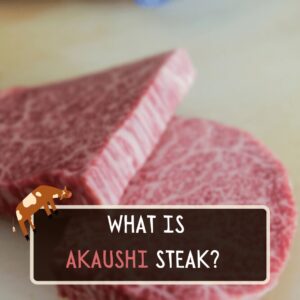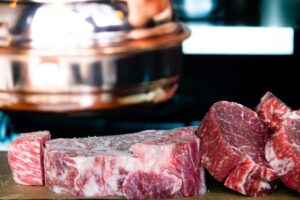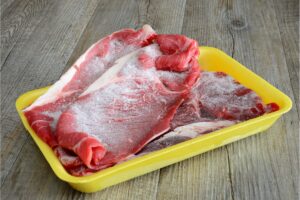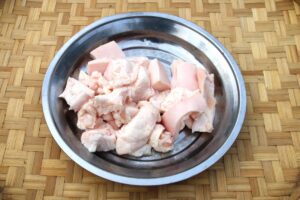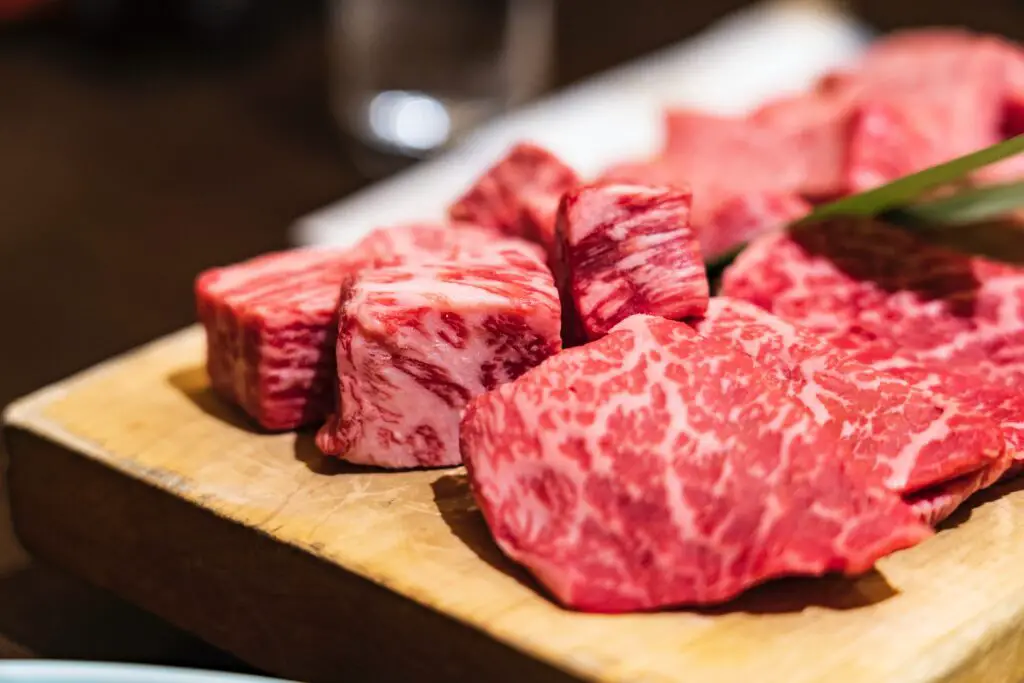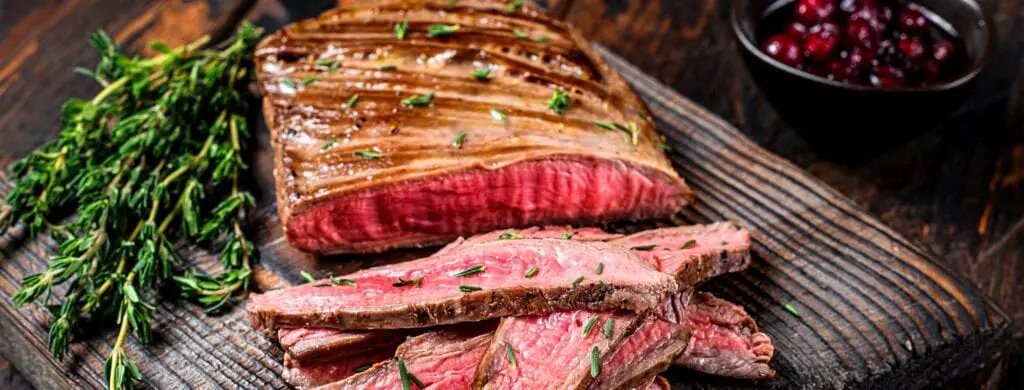
Bavette steak is a flat, highly flavored, loose textured cut of steak. It’s often called the “butcher’s cut”, because butchers used to save it for themselves!
The name comes from French, who call it bavette, meaning “bib”. Bavettes are great in many recipes, especially fajitas, steak salad, steak enchilada, Asian steak stir-fry. This cut is also delicious on its own with a delicious pan sauce!
Bavettes also make excellent homemade steak jerky. However, they are most commonly prepared by grilling, pan frying, broiling, or baking. All of these methods of cooking will increase the tenderness of this steak, making it even more delicious.
If you know that you’re going to be cooking for people who like their food prepared a little differently, I’ve got you.
Bavette steaks are the perfect option because no matter how your guests like their meat prepared, it can be done with a bavette.
Where Does It Come From ?
Bavettes are made from the bottom of the rib cage or underbelly of the cow. These muscles are often referred to as the ‘flank steak’ because they run down the side of the animal.
Bavettes are very lean cuts of meat, but they do tend to be a little harder and more chewy than other popular cuts.
What To Look For
Despite having a tough exterior, when cooked properly, bavettes become incredibly soft and melt in the mouth. If you want to tenderize them, try pounding them with a meat mallet before cooking.
Alternatively, you can try chemical tenderization. To do this, a brine or rub is recommended. Rubs are best if made using a combination of salt, sugar and spices to help break down the tough fibers.
Brining is a method of cooking meat that involves soaking the meat in a solution of salt and water for several days before cooking. By doing this, the meat becomes more tender and flavorsome.
Brining is particularly useful when cooking tougher cuts of meat, such as steaks, because it will help them cook more evenly.
You can also add additional flavorings to your brine. For example, you might add herbs or other seasonings to give a different taste to the meat. As long as there is salt in the solution, the tough fibers will be broken down.
Choosing The Best Steak
There is not really any debate about what kind of meat is healthier and tastier. All studies point to grass fed beef coming out ahead when it comes to taste and health benefits.
I won’t get into the details of why grass-fed beef is better here, but it’s undeniable, grass-fed beef has a richer flavor than grain-fed beef.
In addition, grass-fed beef contains more iron, zinc, vitamin B12, omega 3 fatty acids, conjugated linoleic acid (CLA), and other nutrients.
As such, by enjoying a steak that comes from a grass-fed cow, you aren’t only experiencing a better flavor, but it’s rich in nutrients.
Grass fed beef also tends to have less saturated fats and cholesterol, making it healthier for you. It’s also leaner and lower in calories than grain-fed beef, and it tastes great.
So, when on the lookout for bavette steak, be sure to go with a grass fed option if you get the choice.
Buying Bavette
Bavette steak isn’t always readily available compared to other cuts, but this depends on where you go for your meats.
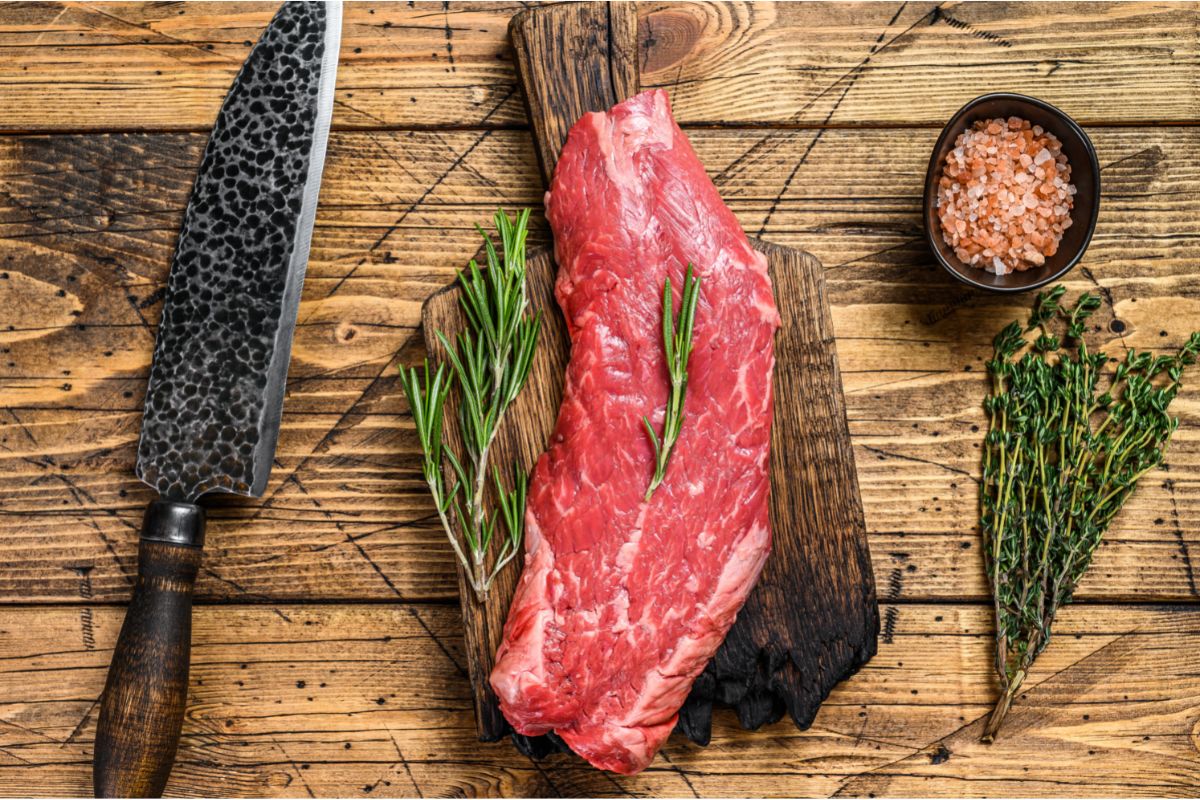
Good butchers will usually be able to offer it, if you call ahead. It might require a little extra work to get your hands on, but the effort is worth it.
Supermarkets won’t necessarily have it in the exact same way that they would stock skirt or flank steak. This is because bavettes aren’t very popular. Why? Maybe because it’s called flap steak, which isn’t really a great marketing name!
However, some people have thankfully managed to get over that. Because of this, It’s been rising in popularity over the years, and should soon be more readily available. Or – at least, I hope so!
The easiest way to get around this lack of availability is to buy beef online.
Here are a few amazing options:
- Snake River Farms American Wagyu Flank Steak
- CrowdCow Bestsellers – Search for Bavette
You can also ask friends or family members if they know someone who raises cattle. If you’re lucky, they’ll even let you come visit them, so you can get an insight into cattle farming as well as a handy discount (maybe).
Aged Bavette
A lot of research has gone into perfecting the art of bavette steak aging. There are many factors that affect how well the meat ages.
For example, if the beef is cooked at high heat, then the protein will break down quicker. I recommend using an airtight container to store your bavettes, since oxygen affects the aging process.
It’s also mandatory to store them in the refrigerator at the proper conditions, because otherwise the meat will simply spoil. No point in going through all that effort to get a bavette only for it to spoil!
How To Cook It
There are many ways to cook a bavette. From frying in a skillet to stewing it, it all depends on what you want to do with it! Generally, it isn’t hard meat to cook, but it does require a little care and attention.
If you want to fry it, you can start cooking it on high, then turn down the heat and let it rest for about 10 minutes.
Once cooked, slice it thinly against the grain, starting at the thickest part of the meat and working your way down. Always serve the beef immediately.
Steak is usually cooked on a cast iron pan, oven, or grill. Grilling steak is great because you can get a great sear on the outside while keeping the meat perfectly medium rare on the inside.
This is done by placing the steak on a cooler side of the grill after searing the surface. If you don’t have a cooler side, then place the steak on top of a piece of foil or another piece of metal that won’t burn.
If you are cooking on a gas grill, try searing the meat first. Gas grills tend to heat up very fast, so if you sear the meat first, it will not burn. When searing, place the steak on top of the grate closest to the flame.
Make sure that there is enough space between the steak and the fire for proper airflow. Cook until the internal temperature reaches 145 °F (65 °C).
Get a meat thermometer if you are unsure about the temperature. Remove the steak from the grill and let it rest for 5 minutes before slicing.
To avoid excessive smoking, the meat should be seasoned before cooking. A well-seasoned steak does not need any oil.
If you season the steak before cooking, then add oil when the steak is almost done. Oil helps the steak brown properly and distributes flavor.
In Summary
Bavette steak is certainly becoming more popular and thus more available, especially at local butchers. With some creativity, bavette steaks can be made into a delicious and nutritious meal.
You certainly won’t be stuck cooking it the same way over and over again. Happy cooking!


